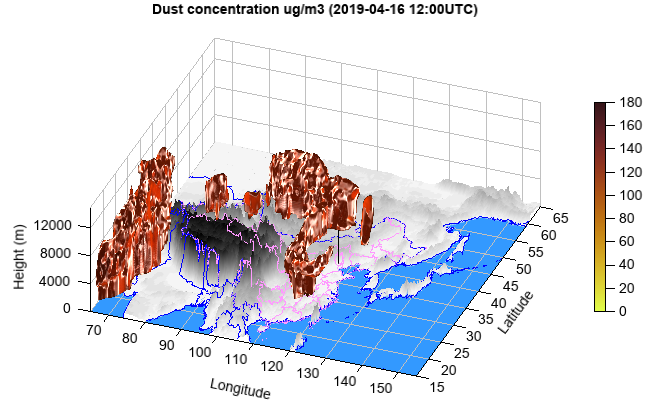volumeplot¶
- Axes3DGL.volumeplot(*args, **kwargs):
creates a three-dimensional volume plot
- Parameters:
x – (array_like) Optional. X coordinate array.
y – (array_like) Optional. Y coordinate array.
z – (array_like) Optional. Z coordinate array.
data – (array_like) 3D data array.
cmap – (string) Color map string.
vmin – (float) Minimum value for particle plotting.
vmax – (float) Maximum value for particle plotting.
ray_casting – (str) Ray casting algorithm [‘basic’ | ‘max_value’ | ‘specular’]. Default is ‘max_value’.
brightness – (float) Volume brightness. Default is 1.
alpha_min – (float) Minimum alpha value. Default is 0.
alpha_max – (float) Maximum alpha value. Default is 1.
opacity_nodes – (list of float) Opacity nodes. Default is None.
opacity_levels – (list of float) Opacity levels. Default is [0., 1.].
- Returns:
Volumeplot graphic
Example of 3D volume plot
fn = 'D:/Temp/image/sagittal.png' data1 = imagelib.imread(fn) data1 = data1[:,:,0] data1 = data1.reshape(88,300,600) data = zeros([176,300,300], dtype='int') data[:88] = data1[::-1,:,:300] data[88:] = data1[::-1,:,300:] data = data.swapaxes(0, 1) ax = axes3d(clip_plane=False) ax.set_draw_box(False) grid(False) volumeplot(data, cmap='NCV_bright')
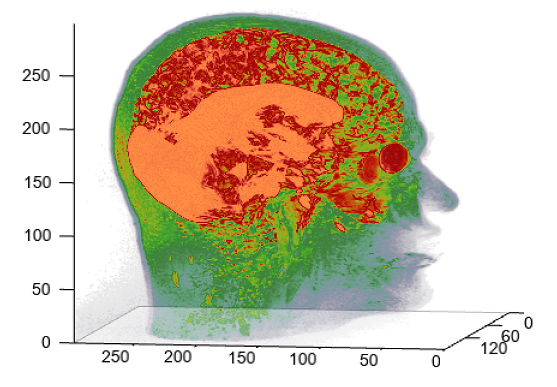
specular ray casting algorithm
fn = 'D:/Temp/image/sagittal.png' data1 = imagelib.imread(fn) data1 = data1[:,:,0] data1 = data1.reshape(88,300,600) data = zeros([176,300,300], dtype='int') data[:88] = data1[::-1,:,:300] data[88:] = data1[::-1,:,300:] data = data.swapaxes(0, 1) print('Plot...') ax = axes3d(orthographic=False, aspect='equal', clip_plane=False, bgcolor='k', axis=False) ax.set_draw_box(False) grid(False) volumeplot(data, cmap='MPL_sstanom', ray_casting='specular', brightness=1.5)
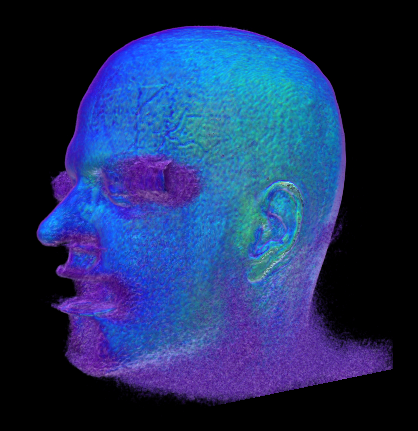
Set transfer function with opacity_nodes and opacity_levels arguments
fn = 'D:/Temp/image/sagittal.png' data1 = imagelib.imread(fn) data1 = data1[:,:,0] data1 = data1.reshape(88,300,600) data = zeros([176,300,300], dtype='int') data[:88] = data1[::-1,:,:300] data[88:] = data1[::-1,:,300:] data = data.swapaxes(0, 1) print('Plot...') ax = axes3d(orthographic=False, aspect='equal', clip_plane=False, bgcolor='k', axis=False) ax.set_draw_box(False) grid(False) volumeplot(data, cmap='MPL_sstanom', ray_casting='specular', brightness=1.5, opacity_nodes=[0,150,200,255], opacity_levels=[0,0,0.5,1])
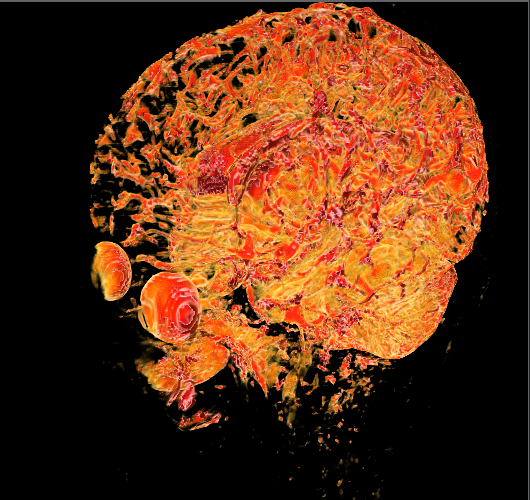
3D volume plot of temperature from numerical forecasting model of GRAPES
print('Read data...') fn = 'D:/Temp/grib/grapes/rmf.tcgra.2021072500042.grb2' f = addfile(fn) tidx = 0 tt = f.gettime(tidx) ss = 5 u = f['u-component_of_wind_isobaric'][tidx,::-1,::-ss,::ss] v = f['v-component_of_wind_isobaric'][tidx,::-1,::-ss,::ss] w = f['Vertical_velocity_geometric_isobaric'][tidx,::-1,::-ss,::ss] u = u[:12] v = v[:12] w = w[:12] speed = sqrt(u*u + v*v + w*w) levels = u.dimvalue(0) lat = u.dimvalue(1) lon = v.dimvalue(2) height = meteolib.pressure_to_height_std(levels * 0.01) print('Plot...') axes3d() geoshow('country', edgecolor='k', edgesize=2, offset=height[5]) ss = 2 streamslice(lon[::ss], lat[::ss], height, u[:,::ss,::ss], v[:,::ss,::ss], w[:,::ss,::ss], zslice=[height[5]], color='b', density=2, interval=10, headwidth=0.2) volumeplot(lon, lat, height, speed, cmap='NCV_bright') colorbar(aspect=30) zticks(height, (levels / 100).astype('int')) xlabel('Longitude') ylabel('Latitude') zlabel('Pressure (hPa)') xlim(lon[0], lon[-1]) ylim(lat[0], lat[-1]) title('Wind speed volume and 850hPa stream line ({})'.format(tt.strftime('%Y-%m-%d %H:00')))
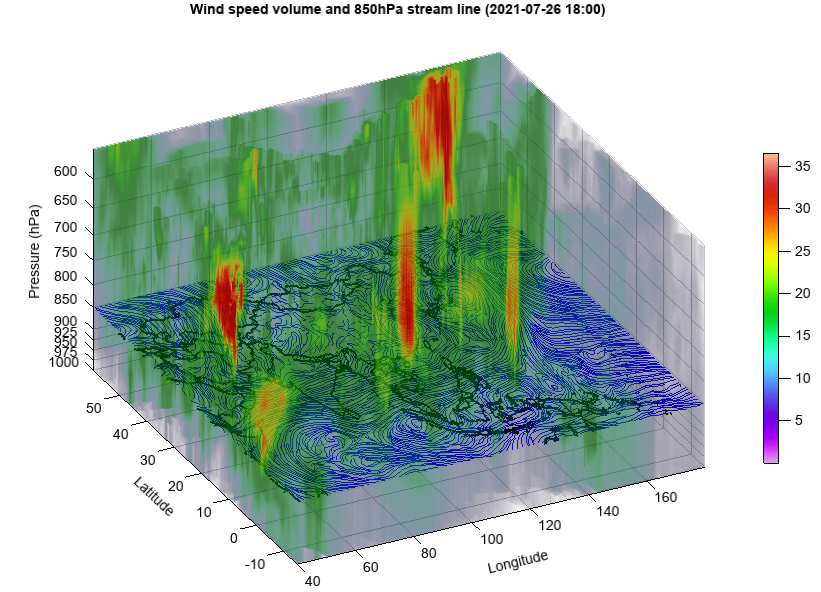
Using transfer function to simulate isosurface plot
#Set date sdate = datetime.datetime(2019, 4, 15, 0) #Set directory datadir = 'D:/Temp/mm5' #Read data fn = os.path.join(datadir, 'WMO_SDS-WAS_Asian_Center_Model_Forecasting_CUACE-DUST_CMA_'+ sdate.strftime('%Y%m%d%H') + '.nc') f = addfile(fn) st = f.gettime(0) t = 12 dust = f['CONC_DUST'][t,:,'15:65','65:155'] levels = dust.dimvalue(0) dust[dust==nan] = 0 height = meteolib.pressure_to_height_std(levels) lat = dust.dimvalue(1) lon = dust.dimvalue(2) #Relief data rfn = 'D:/Temp/nc/elev.0.25-deg.nc' rf = addfile(rfn) elev = rf['data'][0,'15:65','65:155'] elev[elev<0] = -1 lon1 = elev.dimvalue(1) lat1 = elev.dimvalue(0) lon1, lat1 = meshgrid(lon1, lat1) #Map lchina = shaperead('cn_province') clon = lchina.x_coord clat = lchina.y_coord calt = zeros(len(clon)) h = interp2d(elev, clon, clat) calt = calt + h lworld = shaperead('country') wlon = lworld.x_coord wlat = lworld.y_coord walt = zeros(len(wlon)) h = interp2d(elev, wlon, wlat) walt = walt + h #Plot ax = axes3d(clip_plane=False) ax.set_elevation(-20) ax.set_rotation(335) rlevs = arange(0, 6000, 200) cols = makecolors(len(rlevs) + 1, cmap='MPL_gist_yarg', alpha=1) cols[0] = [51,153,255] surf(lon1, lat1, elev, rlevs, facecolor='interp', colors=cols, edge=False) plot3(clon, clat, calt, color=[255,153,255]) plot3(wlon, wlat, walt, color='b') #Beijing location plot3([116.39,116.39], [39.91,39.91], [0,12000]) pp = volumeplot(lon, lat, height, dust, ray_casting='specular', cmap='cmocean_solar_r', vmax=180, brightness=2.5, opacity_nodes=[90,100,120,121], opacity_levels=[0,0.5,0.5,0]) colorbar(pp, aspect=30) xlim(65, 155) xlabel('Longitude') ylim(15, 65) ylabel('Latitude') zlim(0, 15000) zlabel('Height (m)') tt = st + datetime.timedelta(hours=t*3) title('Dust concentration ug/m3 ({}UTC)'.format(tt.strftime('%Y-%m-%d %H:00')))
